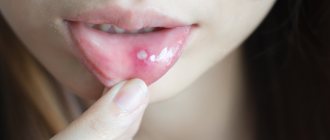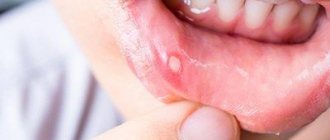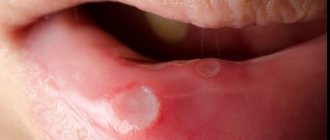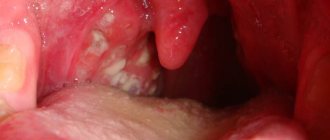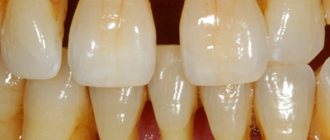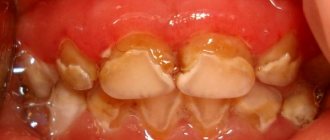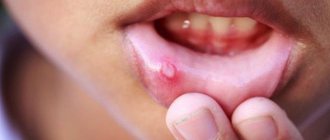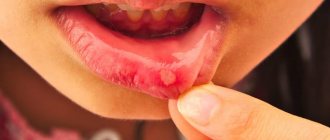The appearance of ulcers in the mouth and inflammation of the mucous membrane are signs of stomatitis. The disease is inflammatory in nature. It occurs as a result of an immune response to external stimuli, often pathogenic microorganisms. It is important to carry out adequate treatment in a timely manner, identify and eliminate the causes. If the disease is not treated, it can become chronic and negatively affect the health of teeth and respiratory organs. A common complication after stomatitis is the addition of a secondary infection.
Reasons for development
Stomatitis often occurs in people with reduced immunity and impaired microflora. If these 2 conditions are observed simultaneously, then even opportunistic microorganisms can cause severe inflammatory processes. Many other factors also influence the development of the disease.
Inflammation of the oral mucosa can occur in the following cases:
- mechanical, chemical, thermal injuries - hot burn, injury from solid food, cheek bite, etc. leads to tissue damage, penetration and spread of infection;
- poor nutrition, lack of vitamins, especially C, group B, minerals - zinc, iron and others;
- failure to comply with hygiene rules, eating unwashed fresh berries, vegetables, fruits, dirty hands while eating;
- treatment with medications that reduce salivation, antibiotics that destroy beneficial microflora, and a number of other medications;
- Frequent brushing of teeth with a paste containing sodium lauryl sulfate leads to a decrease in saliva secretion and dry mucous membranes, which become more susceptible to aggressive substances;
- poor-quality prosthetics and dental treatment due to which the gums are constantly injured;
- smoking, drinking alcohol;
- dehydration with prolonged diarrhea, vomiting.
Stomatitis often occurs during pregnancy due to hormonal imbalance. At risk are patients with diseases of the heart, blood vessels, gastrointestinal tract, pathologies of the immune and endocrine systems, and those with helminthic infestation. In diabetes mellitus, the aphthous form is diagnosed. People who use hormone inhalers to relieve asthma attacks suffer from candidiasis.
To answer the question whether stomatitis is contagious or not, differential diagnosis is necessary. Bacteria, viruses, and Candida fungi can be transmitted from person to person. The most contagious is the viral form of the pathology. However, with good immunity, the infection will not necessarily develop. It is also important how stomatitis is transmitted. If this is direct contact, for example a kiss, then the risk of getting sick is higher.
Symptoms of the disease
Symptoms depend on the type of pathology, but there are common clinical manifestations. As a rule, the disease does not begin acutely. The mucous membranes become red, swelling, pain, and a burning sensation appear in the affected area. You can see what stomatitis looks like in the photo.
If it is a bacterial infection, then after a day an ulcer appears at the site of infection with a red halo radiating from the center. The ulcer is covered with a white coating. During this period, salivation increases and an unpleasant odor appears. Pain bothers the patient not only when eating, but also at rest.
Pimples and ulcers appear anywhere in the oral cavity; in severe cases, stomatitis develops in the throat. Stomatitis on the tongue is especially painful, since there are many nerve endings there. Some types are characterized by bleeding gums.
With further development of the pathology, the temperature may rise, the lymph nodes may enlarge, and symptoms of intoxication may appear - weakness, nausea, lack of appetite.
Signs and symptoms of candidal stomatitis
Patients who develop fungal stomatitis or thrush in the mouth usually complain of pain and discomfort when eating or drinking liquid drinks, impaired taste, difficulty swallowing, and pain, discomfort, constant itching in the mouth, bad breath are also possible in state of rest. Swelling of the cervical lymph nodes is possible, and small children even refuse to drink. The oral mucosa and tongue are covered with a whitish coating, sometimes with a characteristic sign: bleeding appears when the plaque is removed. When thrush spreads to the corners of the mouth, difficulties appear in opening it (the so-called candidiasis).
The initial diagnosis of candidiasis, fungal stomatitis is especially difficult in young children, since at the primary stage only redness is detected, and there is no characteristic plaque. But then whitish small grains appear (resembling semolina grains), which, after increasing in size, take the form of a film or curdled residue. In the absence of treatment for candidal stomatitis, it can progress, plaque covers the entire surface of the oral cavity, the internal layers of the mucous membrane are also affected (acute thrush in the mouth), and with certain predisposing factors, chronic candidal stomatitis .
Types of stomatitis
The disease has a broad classification, which includes the nature of the course, the cause of its occurrence, and the features of the clinical picture.
Pathology can be acute or chronic. If the symptoms are pronounced, there is swelling, redness, pain, ulcers, bleeding - this is acute stomatitis. How long this phase lasts depends on the form of the disease. Usually the duration of the acute period does not exceed two weeks.
If the disease is not treated, remission occurs or the inflammatory process becomes chronic. In the chronic form, the symptoms are mild, and the disease can be detected only during periods of exacerbation.
Drug-induced stomatitis
With increased sensitivity and intolerance to drug components, characteristic symptoms of the disease appear: blisters, erosions, swelling, redness of the pharynx, tongue, palate, burning, dense white coating. The list of medications that cause inflammation of the mucous membranes often includes antibiotics, iodine, barbiturates, novocaine, and sulfonamides.
Traumatic stomatitis
Inflammatory processes develop against the background of tissue injury from objects, chemicals, hot food, etc. Stomatitis on the gums usually occurs due to injury from the uneven edge of a tooth or prosthesis. Bacteria penetrate the wound and it becomes inflamed. Symptoms of catarrhal form are characteristic.
Bacterial stomatitis
Occurs when mucous membranes are damaged by staphylococci and streptococci. It is characterized by the appearance of pustules, which, when opened, transform into erosive foci.
Aphthous stomatitis
It may manifest itself acutely or have mild symptoms. Small spots up to 5 mm of round shape appear - aphthae with clearly defined boundaries, covered with a grayish coating. The spots can be single or multiple. In acute cases, body temperature rises and lymph nodes enlarge. Risk factors include diabetes mellitus, reduced immunity, autoimmune pathologies, diseases of the gastrointestinal tract, especially the large intestine. In the chronic form, it manifests itself asymptomatically; sluggish symptoms are observed during exacerbation.
Catarrhal stomatitis
Diagnosed more often than other forms. It is characterized by mild symptoms: redness, swelling, bleeding gums. Occurs due to poor oral hygiene, decreased immunity, and injuries. It can be a complication of other diseases - influenza, pathologies of the digestive system, blood diseases, vitamin deficiency, endocrine disorders.
Radiation stomatitis
It is the first symptom of radiation sickness. It is characterized by severe dry mouth, pinpoint hemorrhages on the mucous membranes and under the tissues, expansion of periodontal pockets, swelling of the tongue, gums, and palate. Advanced stomatitis of this form is manifested by necrotic foci, strong bad breath, dirty saliva with bloody streaks. Even after treatment, relapses may occur. Scars remain in place of the injured tissue.
Ulcerative stomatitis
It is the next stage after the catarrhal type. Symptoms intensify, ulcers appear, thick plaque, severe pain. Lymph nodes enlarge, and the concentration of leukocytes in the blood increases. At risk are patients with gastrointestinal diseases.
Candidal stomatitis
Fungal infections almost always have a long course. With thrush, a white dense coating appears on the cheeks, tongue, and lips, accompanied by hyperemia and cyanosis of the mucous membranes. In the fugonous form, severe swelling, erosion, and foamy plaque are observed. There is also angular stomatitis, in which fungi affect the corners of the lips (jams). Stomatitis on the lip can be fungal or viral.
Herpetic stomatitis
Develops due to the activity of the herpes virus. Blistering rashes with clear liquid can be seen in the mouth and lips. After the bubbles burst, erosions appear in their place.
Bacterial stomatitis: before and after photos
The causes of infection may be:
- pockets of bacteria accumulation on carious teeth;
- germs entering the mouth due to herpes;
- infection during treatment - bacterial stomatitis can develop if the doctor does not comply with antiseptic rules;
- chronic diseases of various organs;
- contact with a sick person (for example, a kiss).
Symptoms of infectious stomatitis are, first of all, redness of the oral mucosa in the place where microbes entered the wound, swelling, and in the necrotic form, a rash. In children, cracks may form in the mucous membrane, and the gums begin to bleed. The damaged area is itchy and painful.
If bacterial stomatitis is not treated, the temperature rises, a headache appears, the lymph nodes and tonsils become inflamed, and due to intoxication of the body, the rash spreads throughout the body. Children may develop a sore throat and experience pain in the knee joints.
How to treat the disease
Therapy involves the use of local and sometimes systemic drugs. The treatment regimen for the disease depends on what type of stomatitis is diagnosed. For this reason, you should not self-medicate, as it may turn out to be useless and the pathology will continue to develop into dangerous conditions.
The exception is mild catarrhal inflammation associated with poor hygiene. It is enough to exclude the cause and rinse your mouth with antiseptics for several days.
Treatment at home for other types should be discussed with your doctor. The use of folk remedies is not contraindicated, but they can only be used as a supplement to the main therapy. Only a dentist can evaluate the appropriateness and harmlessness of a particular prescription.
Effective drugs for adults
To relieve inflammatory processes, combat pathogenic microflora, and relieve pain, rinses, gels, sprays, lozenges, and ointments are prescribed. For severe pain, pain medications can be taken orally. Since treatment must be carried out regularly, it is important to choose a medicine for stomatitis that will be convenient to carry in your purse and use at work.
Popular medicines:
- Chlorophyllipt, Inhalipt, which have an antiseptic effect. Available in the form of sprays. Apply up to 5 times a day for one week. Sprays are convenient to use if there is stomatitis in the palate or throat.
- Solcoseryl accelerates tissue regeneration, restores mucous membranes, and protects against the development of ulcers. The gel is applied several times a day. The course is from 7 to 14 days.
- Cholisal has a detrimental effect on bacteria, relieves inflammation, and improves tissue healing. The gel is used three times a day for at least a week. An analogue of the drug is Kamistad. Excellent help with aphthous, bacterial form of the disease.
- Viferon, Acyclovir are prescribed to patients with a viral infection. Ointment for stomatitis in the mouth is applied to areas of inflammation several times a day. The course of therapy is up to 2 weeks.
- Lidocaine Asept, Lidochlor are used for any form of pathology, since the main purpose is to relieve acute pain. Available in spray form. Can be used up to four times a day, no more than 1 week.
- Lugol kills bacteria, treats ulcers, and relieves inflammatory processes. The oral cavity is treated with a spray 2 - 3 times a day.
- Miconazole and Nystatin are prescribed for fungal infections. In severe cases of the disease, the ointment is used in combination with systemic medications. Apply to affected areas 2 to 4 times a day.
Any medication for stomatitis must be prescribed by a doctor. The symptoms of the varieties of the disease are similar and it is impossible to independently understand the cause of the inflammatory reactions.
What can you rinse your mouth with?
To treat pathology, you can use pharmaceutical drugs aimed at destroying bacteria, reducing inflammation and healing tissue.
Medicinal solutions that can be bought at the pharmacy:
- Aqualor with sea salt;
- Stomatofit, Dr. Theiss Sage based on sage;
- Romazulan with chamomile extract;
- Chlorhexidine (pre-diluted with water).
Decoctions and infusions for rinsing are easy to prepare at home from chamomile, calendula, aloe juice, sea buckthorn, linden flowers and other medicinal plants. A solution of salt and soda helps a lot.
What is stomatitis? Causes, symptoms, treatment of the disease
Stomatitis is an inflammation of the mucous membrane in the oral cavity. In one form or another, almost every person, starting with infants, has suffered from this disease at least once in their life. The disease can last from 4 days to 2 weeks, depending on the severity and effectiveness of treatment. Effective treatment of stomatitis at home is also possible, but not every form of this disease. If the disease is left to take its course, complications are likely.
Causes of stomatitis and its types
There are certain types of stomatitis, which differ precisely in the causes of the disease:
- fungal - caused by a special fungus Candida albicans and is considered a contagious disease; accordingly, the cause of the disease may be contact with an already sick person or poor oral hygiene;
- aphthous - caused by a lack of essential vitamins and minerals in the body, especially iron and vitamin B 12;
- herpetic - it is provoked by the herpes virus, it is also contagious, the cause is contact with the skin or lips of the patient;
- occurring after external influences - inflammation of the oral mucosa, like stomatitis in adults, often appears due to improperly selected dentures, as a result of frequent alcohol consumption and smoking.
- allergic - this type of stomatitis often occurs after taking certain medications, especially in large quantities;
- which is a reaction to prolonged administration or use of antibiotics that destroy beneficial microorganisms in the oral cavity, it becomes unprotected from any type of bacteria and viruses.
Sometimes the cause of stomatitis can even be low-quality toothpaste, some components of which can irritate the mucous membrane.
Stomatitis
Symptoms
Each type of stomatitis has common symptoms, but may differ in some ways:
- usually the disease begins with slight redness;
- later, the affected areas begin to itch and hurt;
- in advanced cases, bubbles form that can burst;
- fungal stomatitis has a characteristic white coating, especially in infants;
- herpetic stomatitis is expressed in characteristic rashes on the lips, sometimes large and painful;
- if the disease is not treated, it can progress to inflammation in the facial area.
Sometimes stomatitis can be one of the signs of other diseases, such as diabetes.
IMPORTANT! Stomatitis never causes fever, blood pressure, or stomach upset. These symptoms already indicate another concomitant disease, often more serious.
In infants, a symptom of stomatitis may be refusal to feed or unreasonable crying and general anxiety.
Treatment
If the disease is detected at an early stage, you can use proven home remedies. For example, rinse your mouth with a solution of hydrogen peroxide for several days; it is sold in every pharmacy. Only the peroxide itself should be diluted with water in a ratio of 1:5. Regular consumption of fresh yogurt, but without dyes, helps well - this procedure restores healthy microflora. Interestingly, regular consumption of garlic also helps healthy microflora and kills fungi and viruses.
Before deciding how to treat stomatitis, you need to determine what causes it. If antibiotics are used, success can be achieved by limiting their use. If this is an allergic reaction, remove the allergen and take antihistamines.
In cases where you have to deal with a viral or fungal infection, medications are used to treat stomatitis: antiviral ointments and antifungal agents: miramistin or hexoral.
Traditional medicine recommends rinsing the mouth with decoctions of calendula, St. John's wort or chamomile. As a protective agent for the mucous membrane, you can use sea buckthorn oil or ordinary petroleum jelly. Aloe juice is a good disinfectant for the oral cavity.
Prevention
To prevent the occurrence of this disease, you should follow certain simple rules:
- Maintain regular oral hygiene;
- do not abuse sweets and foods containing yeast;
- do not use antibiotics without a doctor’s prescription;
- Smoking and drinking less.
Do not forget about regular visits to the dentist; this often allows you to identify and prevent almost all possible diseases of the teeth and oral cavity.
Prevention
In the oral cavity of any person there is a conditionally pathogenic microflora, which can be activated when immunity decreases. For this reason, it is important to lead a healthy lifestyle, eat well, and treat illnesses.
Hygiene rules must be observed. Do not eat dirty vegetables, wash your hands before eating, and replace your toothbrushes regularly.
For persons predisposed to the disease, any trauma to the oral mucosa should be excluded. Do not eat scalding, hard foods or spicy seasonings. If a wound appears, you should immediately treat it with an antiseptic.
It is imperative to carry out timely treatment of dental and ENT diseases. Chronic diseases and advanced caries are sources of infection.

